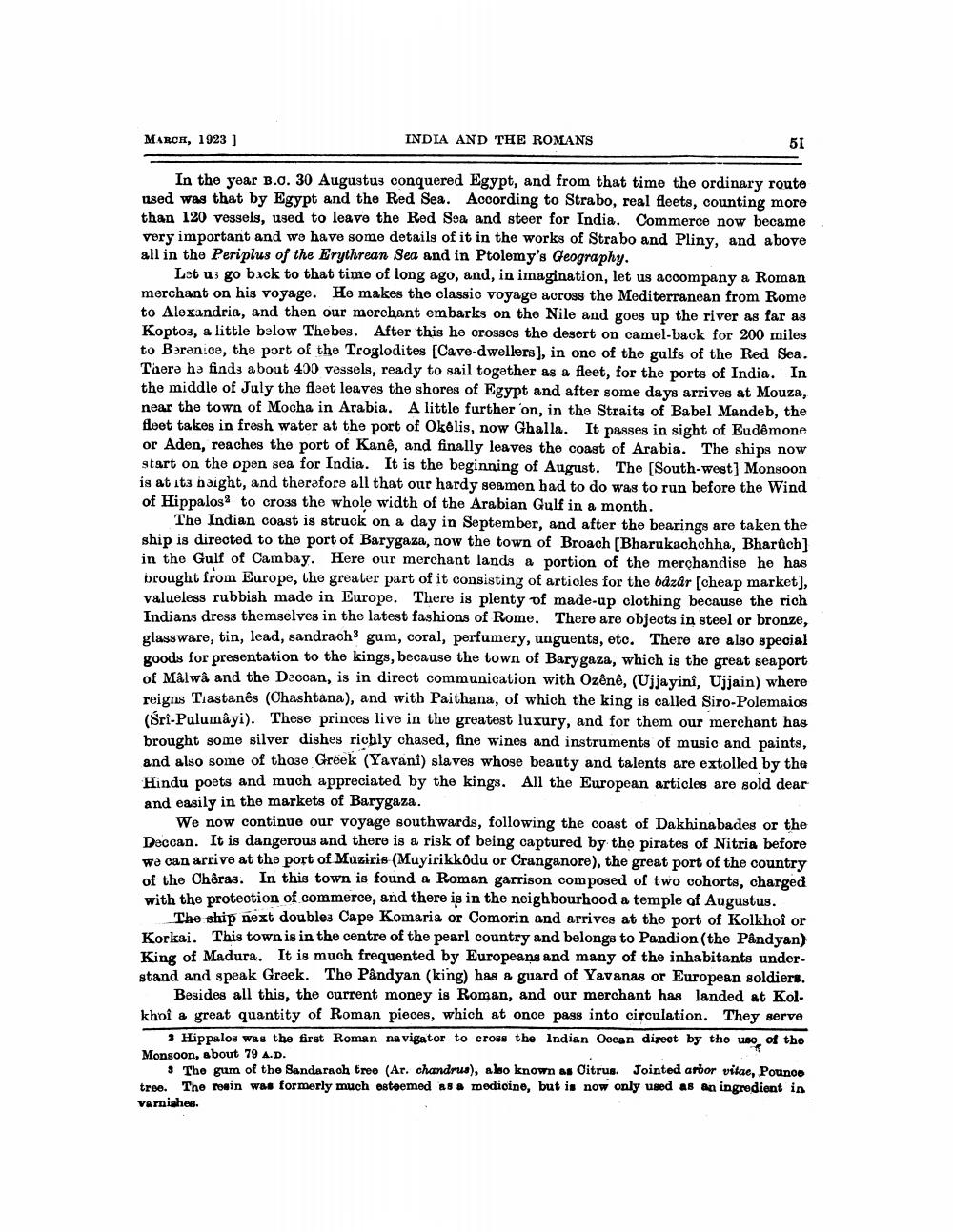________________
MARCH, 1923 ]
INDIA AND THE ROMANS
51
In the year B.O. 30 Augustus conquered Egypt, and from that time the ordinary route used was that by Egypt and the Red Sea. According to Strabo, real fleets, counting more than 120 vessels, used to leave the Red Sea and steer for India. Commerce now became very important and we have some details of it in the works of Strabo and Pliny, and above all in the Periplus of the Erythrean Sea and in Ptolemy's Geography.
Let us go back to that time of long ago, and, in imagination, let us accompany a Roman merchant on his voyage. He makes the classic voyage across the Mediterranean from Rome to Alexandria, and then our merchant embarks on the Nile and goes up the river as far as Koptos, a little below Thebes. After this he crosses the desert on camel-back for 200 miles to Berenice, the port of the Troglodites [Cave-dwellers], in one of the gulfs of the Red Sea. There he finds about 400 vessels, ready to sail together as a fleet, for the ports of India. In the middle of July the fleet leaves the shores of Egypt and after some days arrives at Mouza, near the town of Mocha in Arabia. A little further on, in the Straits of Babel Mandeb, the fleet takes in fresh water at the port of Okėlis, now Ghalla. It passes in sight of Eudêmone or Aden, reaches the port of Kanê, and finally leaves the coast of Arabia. The ships now start on the open sea for India. It is the beginning of August. The [South-west] Monsoon is at its height, and therefore all that our hardy seamen had to do was to run before the Wind of Hippalos to cross the whole width of the Arabian Gulf in a month.
The Indian coast is struck on a day in September, and after the bearings are taken the ship is directed to the port of Barygaza, now the town of Broach [Bharukachchha, Bharuch] in the Gulf of Cambay. Here our merchant lands a portion of the merchandise he has brought from Europe, the greater part of it consisting of articles for the bâzâr [cheap market], valueless rubbish made in Europe. There is plenty of made-up clothing because the rich Indians dress themselves in the latest fashions of Rome. There are objects in steel or bronze, glassware, tin, lead, sandrach3 gum, coral, perfumery, unguents, etc. There are also special goods for presentation to the kings, because the town of Barygaza, which is the great seaport of Malwa and the Deccan, is in direct communication with Ozênê, (Ujjayinî, Ujjain) where reigns Tiastanês (Chashtana), and with Paithana, of which the king is called Siro-Polemaios (Sri-Pulumâyi). These princes live in the greatest luxury, and for them our merchant has brought some silver dishes richly chased, fine wines and instruments of music and paints, and also some of those Greek (Yavanî) slaves whose beauty and talents are extolled by the Hindu poets and much appreciated by the kings. All the European articles are sold dear and easily in the markets of Barygaza.
We now continue our voyage southwards, following the coast of Dakhinabades or the Deccan. It is dangerous and there is a risk of being captured by the pirates of Nitria before we can arrive at the port of Muziris (Muyirikkôdu or Cranganore), the great port of the country of the Chêras. In this town is found a Roman garrison composed of two cohorts, charged with the protection of commerce, and there is in the neighbourhood a temple of Augustus.
The ship next doubles Cape Komaria or Comorin and arrives at the port of Kolkhof or Korkai. This town is in the centre of the pearl country and belongs to Pandion (the Pândyan) King of Madura. It is much frequented by Europeans and many of the inhabitants understand and speak Greek. The Pândyan (king) has a guard of Yavanas or European soldiers.
Besides all this, the current money is Roman, and our merchant has landed at Kolkhoi a great quantity of Roman pieces, which at once pass into circulation. They serve
Hippalos was the first Roman navigator to cross the Indian Ocean direct by the use of the Monsoon, about 79 A.D.
The gum of the Sandarach tree (Ar. chandrus), also known as Citrus. Jointed arbor vitae, Pounce tree. The resin was formerly much esteemed as a medicine, but is now only used as an ingredient in varnishes.




